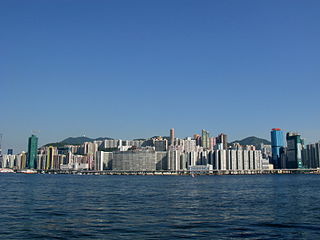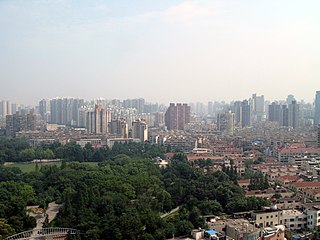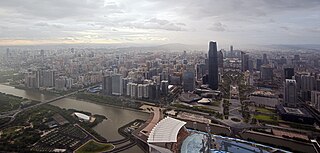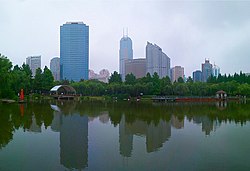
Pudong is a district of Shanghai located east of the Huangpu River across from the historic city center of Shanghai in Puxi. The name refers to its historic position as "The East Bank" of the Huangpu River, which flows through central Shanghai, although it is now administered as the Pudong New Area, a state-level new area which extends all the way to the East China Sea.

Huangpu (help·info) District, makes up the eastern part of Shanghai's traditional urban core and is today the most central of Shanghai's 16 districts. Huangpu district is the seat of municipal government, includes key attractions such as The Bund and the Old City God Temple, as well as popular shopping districts such as Nanjing Road and Huaihai Road. The Huangpu District is one of the most densely populated urban districts in the world.

Jing'an District, is one of the central districts of Shanghai. It has an area of 37 km². With 1,180,000 inhabitants.

Yangpu District is one of the 16 districts of Shanghai. It is located in northeastern part of downtown Shanghai, bordering the Huangpu River on the east and south, Hongkou District on the west, and Baoshan District on the north. The southern part of Yangpu District is 4 km (2.5 mi) away from the Bund, a major tourist attraction. It is predominantly composed of residential communities, with a total area of 60.61 km2 (23.40 sq mi) and a population of 1.313 million as of 2010. The whole district is divided administratively into 11 resident subdistricts and 1 town.

North Point is a mixed-use urban area in the Eastern District of Hong Kong. It is in the northeastern part of Hong Kong Island, between Causeway Bay and Quarry Bay, and projects toward Kowloon Bay.

Hongkou (help·info), formerly spelled Hongkew, is a district of Shanghai, forming part of the northern urban core. It has a land area of 23.48 km2 (9.07 sq mi) and a population of 69,000 as of 1953.

Changning District (help·info), is a district of Shanghai. It has a land area of 37.19 square kilometres (14.36 sq mi) and a population of 620,000 as of 2003. The district government is located at 1320 Yuyuan Rd. Zhongshan Park is located in the district.

Baoshan District (help·info), is a suburban district of Shanghai. It has an area of 424.58 square kilometers (163.93 sq mi) and had a population of 1,905,000 at the time of the 2010 Chinese census.

Minhang District, is a suburban district of Shanghai with a land area of 371.57 km2 (143.46 sq mi) and population of 2,429,000 residents as of 2010. The original Minhang consist of present-day Jiangchuan Road Subdistrict and the eastern strip of Wujing along the Huangpu River in 1992, the surrounding Shanghai County merged with Minhang.

Puxi is the historic center of Shanghai, China, and remains the home of approximately 48% of Shanghai's residents in an area of 288 km². Puxi is distinguished from Pudong to its east, which is separated from it by the Huangpu River. Despite the growing importance of Pudong's Lujiazui area, Puxi remains Shanghai's cultural, residential and commercial center.

Hengshan Road, formerly Avenue Pétain, is a street in the former French Concession of Shanghai, China. A major thoroughfare that connected the heart of the French Concession with the Catholic district of Zikawei (Xujiahui), the boulevard was for much of the 20th century the centre of Shanghai's premier residential district. Since the 1990s, many of the mansions along the road have been converted into bars, night clubs, and restaurants.

Dulwich College Shanghai Pudong (Dulwich Pudong, 上海德威外籍人员子女学校 is a British international school located in Pudong, Shanghai, China. Located 10 miles east of the Shanghai city centre, it caters to expatriate children from Toddler to Year 13.

Tianhe District is one of the eleven districts of Guangzhou, the capital of Guangdong province. In Chinese, the name Tianhe literally means "a river in the sky/heavens", which is also a Chinese name for the Milky Way. It is bordered by Yuexiu District on the west, Baiyun District on the north and Huangpu District on the east. Haizhu District is on its south, though they are separated by the Pearl River.

Line 14 of the Beijing Subway is a rapid transit rail line in the south and east of Beijing. The line is operated by the Beijing MTR Corporation Limited.

Suzhou railway station is a railway station of Jinghu railway and Shanghai–Nanjing intercity railway. The station is located in Suzhou, Jiangsu, China.
Shanghai has a Japanese expatriate group, particularly in. the Gubei area of Changning District, which houses the majority of Japanese expatriates in Shanghai. Some Japanese follow the "Shanghai dream" where they spend several years in Shanghai to gain professional experience or knowledge of Mandarin Chinese, and either continue working in Shanghai or return to Japan later.

Zhuguang Road is a station on Line 17 of the Shanghai Metro. The station is located at the intersection of Songze Avenue and Zhuguang Road in the city's Qingpu District, between Hongqiao Railway Station, the eastern terminus of the line, and Panlong Road. It opened with the rest of Line 17 on 30 December 2017. The station was previously named China Exposition North while it was under construction.

Xujingbeicheng is a station on Line 17 of the Shanghai Metro. The station is located at the intersection of Songze Avenue and Xule Road in the city's Qingpu District, between Xuying Road and Middle Jiasong Road. This station opened with the rest of Line 17 on 30 December 2017.






















